by Calculated Risk on 10/11/2021 08:20:00 AM
Monday, October 11, 2021
Seven High Frequency Indicators for the Economy
These indicators are mostly for travel and entertainment. It will interesting to watch these sectors recover as the pandemic subsides.
The TSA is providing daily travel numbers.
This data is as of October 10th.
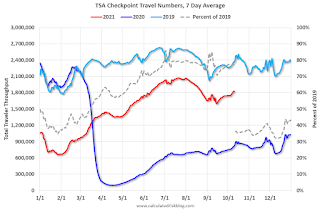 Click on graph for larger image.
Click on graph for larger image.This data shows the 7-day average of daily total traveler throughput from the TSA for 2019 (Light Blue), 2020 (Blue) and 2021 (Red).
The dashed line is the percent of 2019 for the seven day average.
The 7-day average is down 23.0% from the same day in 2019 (77.0% of 2019). (Dashed line)
The second graph shows the 7-day average of the year-over-year change in diners as tabulated by OpenTable for the US and several selected cities.
 Thanks to OpenTable for providing this restaurant data:
Thanks to OpenTable for providing this restaurant data:This data is updated through October 9, 2021.
This data is "a sample of restaurants on the OpenTable network across all channels: online reservations, phone reservations, and walk-ins. For year-over-year comparisons by day, we compare to the same day of the week from the same week in the previous year."
Note that this data is for "only the restaurants that have chosen to reopen in a given market". Since some restaurants have not reopened, the actual year-over-year decline is worse than shown.
Dining picked up for the Labor Day weekend, but declined after the holiday - but might be picking up a little again. The 7-day average for the US is down 6% compared to 2019.
 This data shows domestic box office for each week and the median for the years 2016 through 2019 (dashed light blue).
This data shows domestic box office for each week and the median for the years 2016 through 2019 (dashed light blue). Note that the data is usually noisy week-to-week and depends on when blockbusters are released.
Movie ticket sales were at $159 million last week, down about 13% from the median for the week.
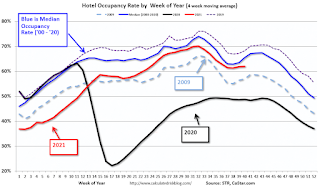 This graph shows the seasonal pattern for the hotel occupancy rate using the four week average.
This graph shows the seasonal pattern for the hotel occupancy rate using the four week average. The red line is for 2021, black is 2020, blue is the median, dashed purple is 2019, and dashed light blue is for 2009 (the worst year on record for hotels prior to 2020).
This data is through October 2nd. The occupancy rate was down 9.2% compared to the same week in 2019.
Notes: Y-axis doesn't start at zero to better show the seasonal change.
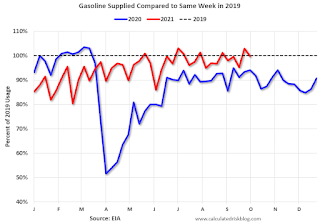 This graph, based on weekly data from the U.S. Energy Information Administration (EIA), shows gasoline supplied compared to the same week of 2019.
This graph, based on weekly data from the U.S. Energy Information Administration (EIA), shows gasoline supplied compared to the same week of 2019.Blue is for 2020. Red is for 2021.
As of October 1st, gasoline supplied was down 0.3% compared to the same week in 2019.
There have been six weeks so far this year when gasoline supplied was up compared to the same week in 2019 - and consumption is running close to 2019 levels now.
This graph is from Apple mobility. From Apple: "This data is generated by counting the number of requests made to Apple Maps for directions in select countries/regions, sub-regions, and cities." This is just a general guide - people that regularly commute probably don't ask for directions.
There is also some great data on mobility from the Dallas Fed Mobility and Engagement Index. However the index is set "relative to its weekday-specific average over January–February", and is not seasonally adjusted, so we can't tell if an increase in mobility is due to recovery or just the normal increase in the Spring and Summer.
 This data is through October 9th for the United States and several selected cities.
This data is through October 9th for the United States and several selected cities.The graph is the running 7-day average to remove the impact of weekends.
IMPORTANT: All data is relative to January 13, 2020. This data is NOT Seasonally Adjusted. People walk and drive more when the weather is nice, so I'm just using the transit data.
According to the Apple data directions requests, public transit in the 7 day average for the US is at 116% of the January 2020 level.
Here is some interesting data on New York subway usage (HT BR).
 This graph is from Todd W Schneider. This is weekly data since 2015.
This graph is from Todd W Schneider. This is weekly data since 2015. This data is through Friday, October 8th.
Schneider has graphs for each borough, and links to all the data sources.
He notes: "Data updates weekly from the MTA’s public turnstile data, usually on Saturday mornings".
Sunday, October 10, 2021
Sunday Night Futures
by Calculated Risk on 10/10/2021 08:00:00 PM
Weekend:
• Schedule for Week of October 10, 2021
Monday:
• Columbus Day Holiday: Banks will be closed in observance of Columbus Day. The stock market will be open. No economic releases are scheduled.
From CNBC: Pre-Market Data and Bloomberg futures S&P 500 are down 23 and DOW futures are down 152 (fair value).
Oil prices were up over the last week with WTI futures at $79.74 per barrel and Brent at $82.65 per barrel. A year ago, WTI was at $40, and Brent was at $42 - so WTI oil prices are UP 100% year-over-year.
Here is a graph from Gasbuddy.com for nationwide gasoline prices. Nationally prices are at $3.26 per gallon. A year ago prices were at $2.18 per gallon, so gasoline prices are up $1.08 per gallon year-over-year.
Reis: Office and Mall Vacancy Rates Decreased Slightly in Q3
by Calculated Risk on 10/10/2021 08:11:00 AM
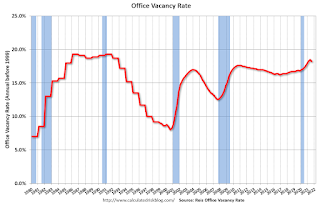 Click on graph for larger image.
Click on graph for larger image.The first graph shows the office vacancy rate starting in 1980 (prior to 1999 the data is annual).
Reis also reported that office effective rents increased slightly in Q3; this followed five consecutive quarter with declining rents.

For Neighborhood and Community malls (strip malls), the vacancy rate was 10.4% in Q3, down from 10.5% in Q2, and unchanged from 10.4% in Q3 2020.
For Regional malls, the vacancy rate was 11.2% in Q3, down from 11.5% in Q2, and up from 10.1% in Q3 2020.
All vacancy data courtesy of Reis
Saturday, October 09, 2021
Newsletter Articles this Week
by Calculated Risk on 10/09/2021 02:11:00 PM
At the Calculated Risk Newsletter this week:
• Measuring Rents How quickly are rents increasing? And how will this impact measures of inflation?
• On Private Lenders Raising the "Conforming Loan Limit" The Official Announcement for 2022 will be in Late November.
• 1st Look at Local Housing Markets in September Denver, Las Vegas and San Diego.
• Homebuilder Comments in September: “Supply chain, supply chain, supply chain." "Monthly price hikes no longer the norm. Some of the hottest markets sounding toppy."
• 2nd Look at Local Housing Markets in September Adding Memphis, Nashville, North Texas (Dallas), Northwest (Seattle), Sacramento and Santa Clara (San Jose).
This will usually be published several times a week, and will provide more in-depth analysis of the housing market.
You can subscribe at https://calculatedrisk.substack.com/ Currently all content is available for free - and some will always be free - but please subscribe!.
Schedule for Week of October 10, 2021
by Calculated Risk on 10/09/2021 08:11:00 AM
The key economic reports this week are September CPI and Retail Sales.
For manufacturing, the October New York Fed survey will be released this week.
Columbus Day Holiday: Banks will be closed in observance of Columbus Day. The stock market will be open. No economic releases are scheduled.
6:00 AM: NFIB Small Business Optimism Index for September.
 10:00 AM: Job Openings and Labor Turnover Survey for August from the BLS.
10:00 AM: Job Openings and Labor Turnover Survey for August from the BLS. This graph shows job openings (yellow line), hires (purple), Layoff, Discharges and other (red column), and Quits (light blue column) from the JOLTS.
Jobs openings increased in July to 10.934 million from 10.185 million in June. This is a new record high for this series.
The number of job openings (yellow) were up 63% year-over-year. Quits were up 25% year-over-year.
7:00 AM ET: The Mortgage Bankers Association (MBA) will release the results for the mortgage purchase applications index.
8:30 AM: The Consumer Price Index for September from the BLS. The consensus is for a 0.3% increase in CPI, and a 0.3% increase in core CPI.
2:00 PM: FOMC Minutes, Meeting of September 21-22, 2021
8:30 AM: The initial weekly unemployment claims report will be released. The consensus is for 315 thousand initial claims, down from 326 thousand last week.
8:30 AM: The Producer Price Index for September from the BLS. The consensus is for a 0.6% increase in PPI, and a 0.5% increase in core PPI.
 8:30 AM ET: Retail sales for September will be released. The consensus is for a 0.2% decrease in retail sales.
8:30 AM ET: Retail sales for September will be released. The consensus is for a 0.2% decrease in retail sales.This graph shows retail sales since 1992. This is monthly retail sales and food service, seasonally adjusted (total and ex-gasoline).
8:30 AM ET: The New York Fed Empire State manufacturing survey for October. The consensus is for a reading of 27.0, down from 34.3.
10:00 AM: University of Michigan's Consumer sentiment index (Preliminary for October).
Friday, October 08, 2021
AAR: September Rail Carloads and Intermodal Down Compared to 2019
by Calculated Risk on 10/08/2021 04:19:00 PM
From the Association of American Railroads (AAR) Rail Time Indicators. Graphs and excerpts reprinted with permission.
Rail traffic in September 2021 was a mix of good and could-be-better, reflecting continuing broad supply chain issues and an economy that doesn’t appear sure where it’s going.
U.S. intermodal volume in September 2021 was down 6.7% from last year and down 0.1% from September 2019. The smooth functioning of intermodal terminals depends on consistent freight outflows to make room for new freight inflows. Unfortunately, that’s not happening right now because of supply chain capacity constraints, with predicable impacts on intermodal. U.S. intermodal in 2021 through September was the second most ever, fractionally behind the first nine months of 2018.
Total U.S. carloads in September were up 4.3% over last year, their seventh straight monthly gain
emphasis added
 Click on graph for larger image.
Click on graph for larger image.This graph from the Rail Time Indicators report shows the six week average of U.S. Carloads in 2019, 2020 and 2021:
U.S. railroads originated 1.17 million total carloads in September 2021, up 4.3% (47,858 carloads) over September 2020 but down 5.8% (71,773 carloads) from September 2019. Total carloads averaged 233,536 per week in September 2021. That’s more than in September 2020, but otherwise it’s the lowest weekly average for September in our data that go back to 1988.
 The second graph shows the six week average (not monthly) of U.S. intermodal in 2019, 2020 and 2021: (using intermodal or shipping containers):
The second graph shows the six week average (not monthly) of U.S. intermodal in 2019, 2020 and 2021: (using intermodal or shipping containers):U.S. railroads originated 1.33 million intermodal containers and trailers in September 2021, down 6.7% from September 2020 and down 0.1% from September 2019. The 6.7% decline in September follows a 3.3% decline in August, which in turn followed a year of monthly intermodal gains. Intermodal volume averaged 265,705 containers and trailers per week in September 2021, the fewest since February 2021 (when a freakishly severe winter storm in Texas and surrounding states decimated rail traffic) and, before that, since July 2020.
October 8th COVID-19: Over 400 Million Doses Administered
by Calculated Risk on 10/08/2021 04:14:00 PM
| COVID Metrics | ||||
|---|---|---|---|---|
| Today | Week Ago | Goal | ||
| Percent fully Vaccinated | 56.3% | 55.7% | ≥70.0%1 | |
| Fully Vaccinated (millions) | 186.9 | 184.9 | ≥2321 | |
| New Cases per Day3 | 93,605 | 106,447 | ≤5,0002 | |
| Hospitalized3 | 62,456 | 72,704 | ≤3,0002 | |
| Deaths per Day3 | 1,421 | 1,554 | ≤502 | |
| 1 Minimum to achieve "herd immunity" (estimated between 70% and 85%). 2my goals to stop daily posts, 37 day average for Cases, Currently Hospitalized, and Deaths 🚩 Increasing 7 day average week-over-week for Cases, Hospitalized, and Deaths ✅ Goal met. | ||||
IMPORTANT: For "herd immunity" most experts believe we need 70% to 85% of the total population fully vaccinated (or already had COVID).
The following 21 states have between 50% and 59.9% fully vaccinated: California at 59.7%, Minnesota, Hawaii, Pennsylvania, Delaware, Florida, Wisconsin, Texas, Nebraska, Iowa, Illinois, Michigan, Kentucky, South Dakota, Arizona, Kansas, Nevada, Alaska, Utah, North Carolina and Ohio at 50.8%.
Next up (total population, fully vaccinated according to CDC) are Montana at 49.0%, Indiana at 48.9%, Missouri at 48.5% and Oklahoma at 48.3%.
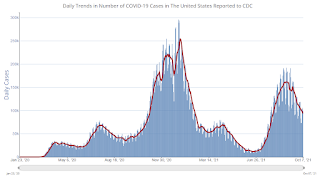 Click on graph for larger image.
Click on graph for larger image.This graph shows the daily (columns) and 7 day average (line) of positive tests reported.
2nd Look at Local Housing Markets in September: Memphis, Nashville, North Texas (Dallas), Northwest (Seattle), Sacramento and Santa Clara (San Jose)
by Calculated Risk on 10/08/2021 02:08:00 PM
Today, in the Newsletter: 2nd Look at Local Housing Markets in September Adding Memphis, Nashville, North Texas (Dallas), Northwest (Seattle), Sacramento and Santa Clara (San Jose)
Excerpt:
Here is a summary of active listings for these housing markets in September. Inventory was up 0.1% in September MoM from August, and down 26.8% YoY.
Inventory in San Diego is at an all time low, whereas inventory in Denver and Sacramento is up more than double from the all time low earlier this year. Sacramento is one of the few areas with inventory up YoY.
Note: New additions to table in BOLD.
Q3 GDP Forecasts: Significant Downgrades
by Calculated Risk on 10/08/2021 12:34:00 PM
| Merrill | Goldman | GDPNow | |
|---|---|---|---|
| 7/30/21 | 7.0% | 9.0% | 6.1% |
| 8/20/21 | 4.5% | 5.5% | 6.1% |
| 9/10/21 | 4.5% | 3.5% | 3.7% |
| 9/17/21 | 4.5% | 4.5% | 3.6% |
| 9/24/21 | 4.5% | 4.5% | 3.7% |
| 10/1/21 | 4.1% | 4.25% | 2.3% |
| 10/8/21 | 2.0% | 3.25% | 1.3% |
From BofA Merrill Lynch:
We are taking down 3Q GDP tracking to 2% from 3.8% previously, reflecting a reassessment of equipment and inventories, and the likely soft retail sales data. [Oct 8 estimate]From Goldman Sachs:
emphasis added
Following today’s payroll miss and outright decline in education payrolls, we lowered our Q3 GDP tracking estimate by ¼pp to 3¼% (qoq ar). [Oct 8 estimate]And from the Altanta Fed: GDPNow
The GDPNow model estimate for real GDP growth (seasonally adjusted annual rate) in the third quarter of 2021 is 1.3 percent on October 8 [Oct 8 estimate]
Reis: Apartment Vacancy Rate Decreased Sharply in Q3
by Calculated Risk on 10/08/2021 11:08:00 AM
Reis reported that the apartment vacancy rate was at 4.7% in Q3 2021, down from 5.3% in Q2, and down from 5.1% in Q3 2020. The vacancy rate peaked at 8.0% at the end of 2009, and bottomed at 4.1% in 2016.

This graph shows the apartment vacancy rate starting in 1980. (Annual rate before 1999, quarterly starting in 1999).
Reis also reported the asking rents were up 7.5% year-over-year, compared to up 1.2% in Q2.



